You cannot miss Orly Genger’s Red, Yellow and Blue art installation this summer in Manhattan. If people say this statement, they may mean, “You have got to see this!” Or, they may mean, “You cannot escape seeing this!” when walking through Madison Square Park. During the late spring and summer, this 166-year-old gracious park has been home to a huge, wavy art installation that takes up three large, separate spaces of its handsome lawns. The Madison Square Park Conservancy commissioned the artist’s installation, which the group debuted on May 2. It will be in the square until Sept. 8, and will then be on view at the deCordova Sculpture Park and Museum, in Lincoln, Mass., in October.
Like many New Yorkers and visitors, I have always prized Madison Square Park for its openness and winding walkways, the shade and respite of its old and graceful trees, and its views of the Flatiron Building, the Metropolitan Life Tower, and other places that speak of a cosmopolitan, historic city. Even with the park’s ultra-now Shake Shack and new playgrounds, its spacious feeling makes it a walker’s delight, like something out of the early 20th century.
Genger’s gigantic artwork produces another walking experience entirely, foremost because of its vast size and bright primary colors, amid the setting of a leafy, open park. For four months, the installation is taking over a very big portion of Madison Square Park, which influences how people use and enjoy the space. Don’t get me wrong – the initiative to make public art for all is praiseworthy. Many love these installations in cities and towns globally. Still, I wonder about one dominating large areas of a relatively compact urban park for many warm weather months, when people especially embrace their neighborhood square. Some may well appreciate Genger’s art. However, this installation and its bulky character feel in-your-face and so opposing to the square’s openness and views.
Red, Yellow and Blue is, to be sure, an artwork of major ambition as well as size. Genger has become known in the art world for massive installations out of rope that she and those assisting her knot, crochet, and shape into various forms. This art commission is the marriage of an artist who has produced attention-getting, giant rope-based artworks and a conservancy known for sponsoring larger-than-life installations at the square. A long list of foundations and donors supports the Mad. Sq. Art program. This work follows the Brooklyn-based Genger’s other large-scale installations elsewhere, for example, the 2008-2009 Whole at the Indianapolis Museum of Art and 2009-2010 Big Boss, for which she used 100 miles of painted rope in a towering wall, at MASS MoCA (Massachusetts Museum of Contemporary Art).
Everything about Red, Yellow and Blue is big, including the effort that went into it. For the Madison Square Park commission, Genger used 1.4 million feet of nautical rope, which she collected up and down the Eastern seaboard. Assistants, mostly women, aided Genger in cleaning lobster claws and fish bones out of the rope, according to a New York Times story about the installation. Cleaning, crocheting, and priming the rope took many hours on a daily basis. Once the artist and her assistants cleaned the material, the artist used some 3,500 gallons of paint to cover it. Finally, the artist shaped the knotted rope into three separate wavy works.
How Does It Stack Up?
Such a humongous art installation – at 4,500 square feet – doesn’t grace the landscape, it takes over, in many respects. That appears to be the intention. In the press release that accompanied the artwork’s debut, the Madison Square Park Conservancy says, “Together, three separate undulating structures of layered rope shaped on-site by the artist will redefine the landscape of the park, creating interactive environments that will invite visitors to explore both exposed and hidden spaces, encouraging them to navigate and experience Madison Square Park anew.”
Red, Yellow and Blue interrupts more than invites interaction, I found in walking through the park. Its primary colors are beautiful, but its waving shape and tall height over three distinct areas of the lawn form barriers. They block views through the park – the sights of the large trees, flowers and plants, wrought-iron railings, and the architectural profiles of buildings edging the square that blend together in memorable, eye-pleasing scenes. In some places the artwork actually hems in trees, giving a sense of encroaching on nature – like the tree trunks don’t have enough room to breathe. It may not be a reality, but it’s a sense from seeing the knotted roping surround a tree this way.
Genger aimed to fashion an artwork that would “engage rather than intimidate,” the Madison Square Conservancy release quotes her as saying. She cited the tradition of knitting that carries the sharing of stories, adding, “The repurposed rope brings with it the stories of different locations and by knotting it, a space is created for the words and thoughts of viewers in New York City to complete the work, creating a silent dialogue that waves along.”
My sensation of obstruction isn’t surprising, or even negative, if one judges from the descriptions by various members of the art and style world – and what they observe as an intention to provoke. On one blog, stylecurated, the writer notes: “Artist Orly Genger and team engages viewers with the way the installation occupies, interferes with, and obstructs public space. As with past indoor and outdoor installations, Genger includes the audience by replacing their normal path or line of sight with a grossly unavoidable structure/pop of color.” In summing up Genger’s approach, Museo magazine points out that once Genger ties the rope into massive knots and then coaxes it into enormous accumulations, “She then leaves the work for the public to navigate in experiences that are often physically and psychologically engaging due to the ways in which the installations occupy, and often obstruct space.”
“More Huge Barriers”
Is this a good thing? Does anybody get that we’re talking about installing these rope artworks in a small piece of Manhattan space that is natural and fairly open – a green space in the middle of vast amounts of concrete, stone, and glass? New Yorkers crave and cherish their natural spaces and experiences of nature. This helps the crowded city, in essence, to breathe and to walk with ease. I think of children who love to play in grass and dirt as well as adults who savor Madison Square’s views and natural beauty. Yet this big art installation, in three different spaces, interrupts it all. (Does it make for a good game of hide and seek? Perhaps it does.) When I consider this installation in place for one-third of a year, I wonder if, in fact, it doesn’t usurp park space that many hold dear.
Apparently I’m not alone in thinking this way. When Curbed NY reported on the installation’s May opening, the article drew some unenthusiastic responses. One reader says he/she is “not a fan of something that creates more huge barriers in this town.” Another adds, “Your photos make it look beautiful – however, I didn’t find it that pretty in person. You took these pretty photos from great angles, I felt in person that it was just some big plastic wall in my face preventing me from enjoying the park.” A third commenter says, “Remember when parks were used as, you know, parks?”
Conversely, others praise the artwork, such as one blogger on Martha Stewart’s site, The Crafts Dept., who exclaims, “It really is a great experience to walk around in.” Other writers have termed it “fun” and “gaze-worthy.” One European tourist told me, “I like looking at it and I like looking at the rest of the park, too.” During the summer, the Madison Square Park Conservancy has used this event as a jumping-off point to offer family art workshops on weaving and color.
In my walking there, I’ve watched how people responded to Genger’s work. Some sat on the grass inside its boundaries. Various people took photos of the rope installation while some others read the sign about it. Many others simply walked by it. It’s likely to have sparked a range of responses.
In the article about Genger’s Red, Yellow and Blue, the New York Times writer says Genger’s “seemingly endless coils of rope” recall other Modern masterpieces. When Genger filled up a Chelsea gallery in 2007 with 250,000 feet of painted, knotted rope its lava-like environment suggested Walter De Maria’s Earth Room sculptures, according to the writer. De Maria’s 1977 work, The New York Earth Room, is an installation of thousands of pounds of soil spread over 3,600 square feet in the room of a SoHo gallery. That is it – soil in a room that the Dia Art Foundation has maintained for more than three decades. One artist creates a work by showcasing a room full of soil while another makes an installation that covers over the precious soil we have in New York City.
It’s ironic, to say the least.
If you have seen Orly Genger’s Red, Yellow and Blue this summer at Madison Square Park, Mindfulwalker.com would welcome hearing your response to the art installation.
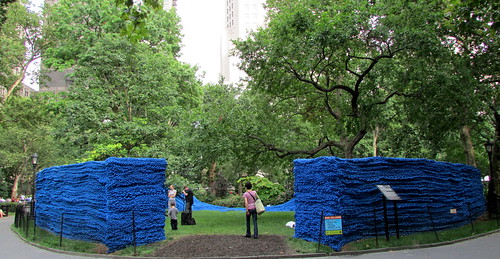
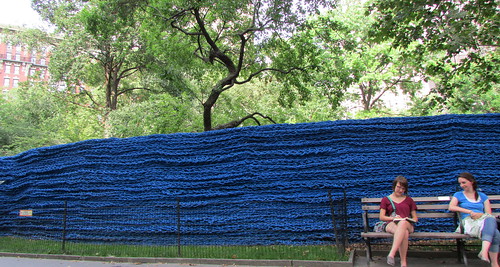
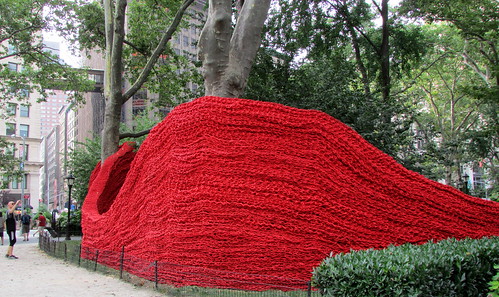
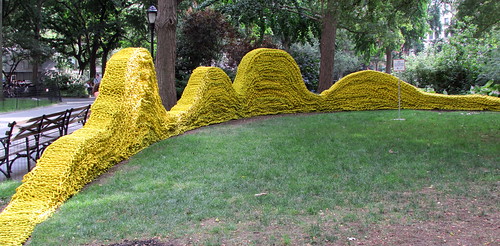
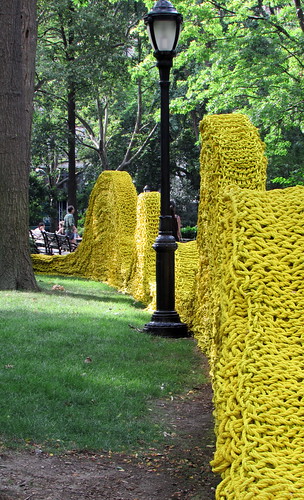



Truthfully, it makes me think of alternatives to building materials so it prompts the imagination that way. Why not use this stuff to build walls (inside or out) or houses? camp? a little bit of ah ha here. For sure, I could see miniature landscape segments for regular folk. (and I stress miniature here). I would have a field day with little curvy or free form segments along a patio walk to complement my coneflowers or daisies. I am not ignoring the pure art form of the display, as intended. I am just expanding my mind to the inspiration that comes from it. Like it or not, it is temporary and will not remain as a permanent fixture in the park. If I had to weigh in, I would say good.
Great research and thoughtful review, Susan!
I can’t help but wish the rope had been left au naturel, with lobster claws and fish bones attached….
I went to Madison Square Park yesterday specifically to see this exhibit. I was sort of underwhelmed, actually. I found it interesting but not particularly attractive or appealing from the standpoint of public art. I hadn’t thought of it in terms of barriers and actually liked the yellow one some.
Thank you so much for your comments, Lynne, Gretchen, and Karen. It’s excellent to get people’s responses (which I’ve had on Facebook as well).
Lynne, I can understand your thinking of alternatives to business materials when seeing it. Such an inventive mind!
Karen, interesting that you should say “underwhelmed” because when I observed people during my time at Madison Square Park, that is one sense that struck me. People may have taken photos or read the sign about it, but they didn’t really spend much time around it at all. Funny, because if I had to pick, I’d say I had a more positive feeling about the yellow one than the others. I positively hated the way the red one crowded the trees and the area around them.
And Gretchen, thank you – and I LOVE your wry suggestion, which says so much!
The excellent pictures show so much: This is an insult to the natural beauty of the park — the trees and even the historic lamp posts look disconcerted and overwhelmed by it. I worked on the Gates project in Central Park, and it was a collaboration with nature, not a competition with it.
Many public art projects in this park have been moving, and have not competed with what the park was put there for in the first place: To be able to take uninterrupted refuge in natural elements that are so rare in a city — green open space, the bark of a tree, the grace of a flower.